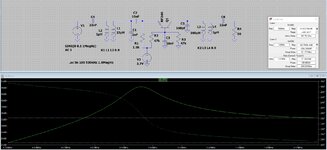RadioHobbies
Newbie level 4
Trying to adjust the bias of the above circuit , I noticed that the 37 k pot need to be at its highest value ,
ie : the circuit need more positive voltage on the base
then the maximum gain I've got was when I connect the base to the ground (positive terminal by removing resistors & cap)
That gain wasn't enough though
I thought of the collector should have a resistor to make the pot have a center point
I added a 2.7 k resistor to the circuit in the series with the collector (and a 103 cap for passing the signal to the ground), that was right ,
the pot now have a center point where the gain reach its maximum value ,
then get decreased when the pot value exceed some point but in that arrangement , the gain became
very low (less than before)
I am not familiar with common base amplifiers
any suggestions please ?
